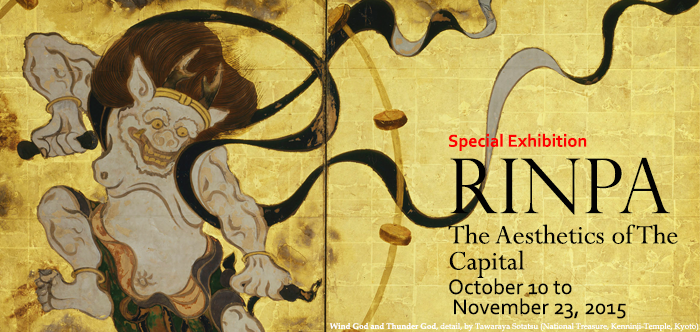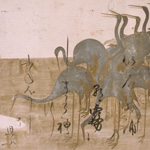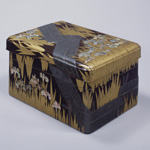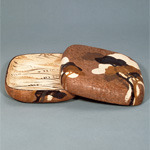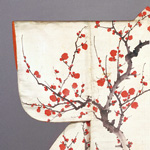General Information
| Exhibition Title | RINPA: The Aesthetics of the Capital |
|---|---|
| Period | October 10 - November 23, 2015 |
| Venue | Heisei Chishinkan |
| Transportation | JR, Kintetsu Railway, Keihan Railway, Hankyu Railway, City Bus |
| Special Exhibition Hours | 9:30 a.m.-6:00 p.m. (Entrance Until 5:30 p.m.) Fridays 9:30 a.m.-8:00 p.m. (Entrance Until 7:30 p.m.) |
| Closed | Closed on Monday *When Monday is a national holiday, the museum remains open on monday and closes the following Tuesday. |
| Special Exhibition Admission | Adult \1,500 (\1,300) Univ. Student \1,200 (\1,000) High School Student \900 (\700) Admission is free under middle school students. *(Fees in parentheses for groups of twenty or more) |
| Organized by | Kyoto National Museum, Nikkei Inc., Television Osaka Inc., BS Japan Corporation, The Kyoto Shimbun Co.,Ltd. |
| Sponsored by | Bank of Kyoto, Ltd., Kyoto College Of Arts And Crafts, Central Japan Railway Company, Panasonic Corporation, WACOAL CORP., Nissha Printing Co., Ltd. |
| Cooperated by | Iwatani Corporation, OMRON Corporation, Nippon Kodo Co.,Ltd |
Images from the Exhibit
2015 marks the 400th anniversary of the origins of Rinpa and nearly 300 years since the death of its eponymous artist Ogata Kōrin. Among the various anniversary celebrations taking place in Japan this year, the Kyoto National Museum's commemorative special exhibition is perhaps the ultimate presentation of this subject, tracing the transmission of the Rinpa aesthetic from its inception through the Edo period (1615–1868). Significantly, it is also the first major show of its kind to be held in the birthplace of Rinpa—the ancient capital of Kyoto.
Rinpa (alternatively spelled Rimpa) is a revivalist aesthetic style based on classical artistic and literary traditions. Rinpa works are often characterized by subject matter taken from nature or classical Japanese literature; they frequently have a decorative sensibility and sometimes abstracted design elements and distinctive techniques.
The Rinpa tradition is best represented by three master artists who lived and worked at different periods in early modern Japan: Tawaraya Sōtatsu (active early 1600s), Ogata Kōrin (1658–1716), and Sakai Hōitsu (1761–1828). The term Rinpa—which is combined from the second character in Kōrin's name and the character for "school" or "style"—was coined in modern times and did not exist during the Edo period. Though sometimes described as a school, Rinpa is less a direct lineage of teachers and their disciples than a lineage of personal artistic influence: Sōtatsu's work inspired Kōrin, whose oeuvre, in turn, influenced Hōitsu. Of course, these three artists never actually met: most artists working in the Rinpa mode discovered the aesthetic for themselves and pursued it out of admiration for their artistic predecessors. The Kyoto National Museum's exhibition features the National Treasure screens Wind God and Thunder God by Sōtatsu as well the very important later Wind God and Thunder God screens produced by Kōrin (Important Cultural Property) and by Hōitsu in homage. This is the first time in seventy-five years that all three sets of screens have been brought together for an exhibition in Kyoto.
While Rinpa is most closely associated with a few famous masters, its influence can be seen across a broad range of Japanese artistic genres. These diverse traditions are tied together by an aesthetic preference for decorating the arts of daily life. The man who established the aesthetic framework of Rinpa is Hon'ami Kōetsu (1558–1637), a calligrapher who was also deeply involved in the arts of lacquer and ceramics. Outstanding works by Kōetsu and his fellow Rinpa founder Tawaraya Sōtatsu form the cornerstones of this exhibition. Visitors will receive a thorough introduction to the works of Kōetsu, who came from an elite merchant family of sword polishers and appraisers, and to those of Sōtatsu, the consummate master about whom much remains unknown. Kōetsu and Sōtatsu’s collaborative masterpiece Anthology with Cranes (also known as The Crane Scroll, designated as an Important Cultural Property) will be shown in its 13.56-meter-long entirety for the duration of the exhibition.
Next up are masterworks by the brothers Ogata Kōrin and Ogata Kenzan (1663–1743), who were born into the wealthy merchant family owners of the Kyoto textile emporium Kariganeya. One highlight of this section is a close examination of Kōrin-related materials in the Kyoto National Museum collection, which help elucidate the lives and personalities of these two men and give background on Kōrin's career.
Late in their lives, both Kōrin and Kenzan left Kyoto for Edo (present-day Tokyo), inspiring a new branch of Rinpa-style art in eastern Japan. The most important name associated with Edo Rinpa is Sakai Hōitsu. Born the younger brother of a Sakai daimyo lord in Himeiji, Hōitsu had an unusually noble rank for an artist. After deciding to devote himself to Rinpa, he spent his life painting as well as researching and honoring his artistic predecessors, even organizing a centennial anniversary of Kōrin's death. Today, Hōitsu's efforts form the foundation of modern Rinpa scholarship.
The presence of Rinpa in Kyoto this autumn is not limited to the Kyoto National Museum’s exhibition galleries. Directly in front of the museum is the temple of Yōgen-in, whose interior is decorated with paintings by Sōtatsu. Farther north in Kyoto is the temple of Myōken-ji, home to the graves of Kōrin and his brother Kenzan. And on the northwest edge of the city is Takagamine, where 400 years ago Kōetsu established a spiritual and artistic community on land granted to him in 1615 by Shogun Tokugawa Ieyasu.
The Kyoto National Museum shows Rinpa in its birthplace, surrounded by the geographic and cultural context that nurtured it. This exhibition follows the aesthetic path of Rinpa—founded on the courtly arts and culture of Japan’s ancient capital—over the course of its development, its veneration, and its reinvention by new personages during the Edo period.











